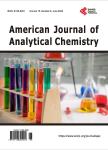Visible and Near-Infrared Spectroscopic Discriminant Analysis Applied to Identification of Soy Sauce Adulteration
Visible and Near-Infrared Spectroscopic Discriminant Analysis Applied to Identification of Soy Sauce Adulteration作者机构:Department of Biological Engineering Jinan University Guangzhou China Guangdong Langtao Science and Technology Co. Ltd. Dongguan China Department of Optoelectronic Engineering Jinan University Guangzhou China
出 版 物:《American Journal of Analytical Chemistry》 (美国分析化学(英文))
年 卷 期:2022年第13卷第2期
页 面:51-62页
学科分类:0202[经济学-应用经济学] 02[经济学] 020205[经济学-产业经济学]
主 题:Visible and Near-Infrared Spectroscopy Soy Sauce Adulteration Identification Partial Least Squares-Discriminant Analysis Standard Normal Variate
摘 要:The identification of soy sauce adulteration can avoid fraud, and protect the rights and interests of producers and consumers. Based on two measurement models (1 mm, 10 mm), the visible and near-infrared (Vis-NIR) spectroscopy combined with standard normal variate-partial least squares-discriminant analysis (SNV-PLS-DA) was used to establish the discriminant analysis models for adulterated and brewed soy sauces. Chubang soy sauce was selected as an identification brand (negative, 70). The adulteration samples (positive, 72) were prepared by mixing Chubang soy sauce and blended soy sauce with different adulteration rates. Among them, the “blended soy sauce sample was concocted of salt water (NaCl), monosodium glutamate (C5H10NNaO5) and caramel color (C6H8O3). The rigorous calibration-prediction-validation sample design was adopted. For the case of 1 mm, five waveband models (visible, short-NIR, long-NIR, whole NIR and whole scanning regions) were established respectively;in the case of 10 mm, three waveband models (visible, short-NIR and visible-short-NIR regions) for unsaturated absorption were also established respectively. In independent validation, the models of all wavebands in the cases of 1 mm and 10 mm have achieved good discrimination effects. For the case of 1 mm, the visible model achieved the optimal validation effect, the validation recognition-accuracy rate (RARV) was 99.6%;while in the case of 10 mm, both the visible and visible-short-NIR models achieved the optimal validation effect (RARV = 100%). The detection method does not require reagents and is fast and simple, which is easy to promote the application. The results can provide valuable reference for designing small dedicated spectrometers with different measurement modals and different spectral regions.



